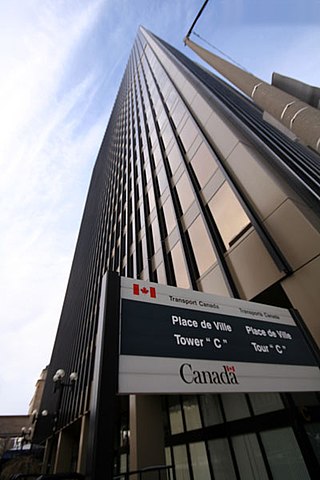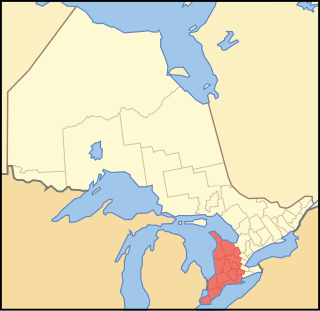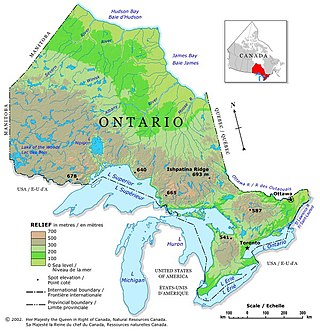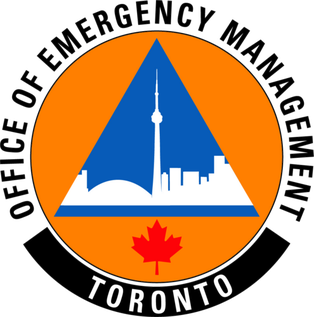Related Research Articles

Ontario is the southernmost province of Canada. Located in Central Canada, Ontario is the country's most populous province. As of the 2021 Canadian census, it is home to 38.5 percent of the country's population, and is the second-largest province by total area. Ontario is Canada's fourth-largest jurisdiction in total area of all the Canadian provinces and territories. It is home to the nation's capital, Ottawa, and its most populous city, Toronto, which is Ontario's provincial capital.

Franco-Ontarians are Francophone Canadians that reside in the province of Ontario. Most are French Canadians from Ontario. In 2021, according to the Government of Ontario, there were 650,000 Francophones in the province. The majority of Franco-Ontarians in the province reside in Eastern Ontario, Northeastern Ontario, and Central Ontario, although small francophone communities may be found in other regions of the province.

The Golden Horseshoe is a secondary region of Southern Ontario, Canada, which lies at the western end of Lake Ontario, with outer boundaries stretching south to Lake Erie and north to Lake Scugog, Lake Simcoe and Georgian Bay of Lake Huron. The region is the most densely populated and industrialized in Canada. Based on the 2021 census, with a population of 7,759,635 people in its core and 9,765,188 in its greater area, the Golden Horseshoe accounts for over 20 percent of the population of Canada and more than 54 percent of Ontario's population. It is part of the Quebec City–Windsor Corridor, itself part of the Great Lakes megalopolis.
A regional municipality is a type of Canadian municipal government similar to and at the same municipal government level as a county, although the specific structure and servicing responsibilities may vary from place to place. Regional municipalities were formed in highly populated areas where it was considered more efficient to provide certain services, such as water, emergency services, and waste management over an area encompassing more than one local municipality. For this reason, regions may be involved in providing services to residents and businesses.

Southern Ontario is a primary region of the Canadian province of Ontario. It is the most densely populated and southernmost region in Canada, with approximately 13.5 million people, approximately 36% of Canada's population of 37 million. The region lies south of the province's other primary region, Northern Ontario, although the exact northern boundary of Southern Ontario is disputed. However, its core region is situated south of Algonquin Park, the latter being in an area of transition between coniferous forest north of the French and Mattawa Rivers and southern deciduous forest. It covers between 14 and 15% of the province, depending on the inclusion of the Parry Sound and Muskoka districts which also lie in the transitional area between northern and southern forest regions. Southern Ontario differs greatly from Northern Ontario, having a much higher population density, a different climate, and a different culture than its northern counterpart. It is broken into smaller subregions, including Central Ontario, Eastern Ontario, the Golden Horseshoe, and Southwestern Ontario.

Transport Canada is the department within the Government of Canada responsible for developing regulations, policies and services of road, rail, marine and air transportation in Canada. It is part of the Transportation, Infrastructure and Communities (TIC) portfolio. The current Minister of Transport is Pablo Rodriguez. Transport Canada is headquartered in Ottawa, Ontario.
Public Safety Canada, legally incorporated as the Department of Public Safety and Emergency Preparedness (PSEPC), is the department of the Government of Canada responsible for (most) matters of public safety, emergency management, national security, and emergency preparedness in Canada.

Southwestern Ontario is a secondary region of Southern Ontario in the Canadian province of Ontario. It occupies most of the Ontario Peninsula bounded by Lake Huron, including Georgian Bay, to the north and northwest; the St. Clair River, Lake St. Clair, and Detroit River, to the west; and Lake Erie to the south. To the east, on land, Southwestern Ontario is bounded by Central Ontario and the Golden Horseshoe. The region had a population of 2,796,367 in 2021. It is sometimes further divided into "Midwestern Ontario" covering the eastern half of the area and the heart of Southwestern Ontario encompassing the western half of the region.

The Northern Development, Mines, Natural Resources and Forestry is a government ministry of the Canadian province of Ontario that is responsible for Ontario's provincial parks, forests, fisheries, wildlife, mineral aggregates and the Crown lands and waters that make up 87 per cent of the province. Its offices are divided into Northwestern, Northeastern and Southern Ontario regions with the main headquarters in Peterborough, Ontario. The current minister is Greg Rickford.

The Canadian Automobile Association is a federation of eight regional not-for-profit automobile associations in Canada, founded in 1913. The constituent associations are responsible for providing roadside assistance, auto touring and leisure travel services, insurance services, and member discount programs within their service territories. The CAA National Office in Ottawa coordinates relations between the clubs, oversees joint initiatives, and lobbies the federal government. In 2020 and 2021, the Gustavson Brand Trust Index named CAA the most trusted brand in Canada.
Nuclear power in Canada is provided by 19 commercial reactors with a net capacity of 13.5 gigawatt (GW), producing a total of 95.6 terawatt-hours (TWh) of electricity, which accounted for 16.6% of the country's total electric energy generation in 2015. All but one of these reactors are located in Ontario, where they produced 61% of the province's electricity in 2019. Seven smaller reactors are used for research and to produce radiopharmaceuticals for use in nuclear medicine.
The Ministry of Emergency Management and Climate Readiness (EMCR), formerly Emergency Management BC (EMBC), is a provincial government department in the Canadian province of British Columbia. EMCR works with local governments and other provincial and federal agencies year round, providing coordination and support before, during and after emergencies. EMCR is administered under the Emergency Program Act.

Ontario is located in East/Central Canada. It is Canada's second largest province by land area. Its physical features vary greatly from the Mixedwood Plains in the southeast to the boreal forests and tundra in the north. Ontario borders Manitoba to the west, Hudson Bay and James Bay to the north, Quebec to the east, and the Great Lakes and the United States to the south. The province is named for Great Lake Ontario, an adaptation of the Iroquois word Onitariio, meaning "beautiful lake", or Kanadario, variously translated as "beautiful water". There are approximately 250,000 lakes and over 100,000 kilometres (62,000 mi) of rivers in the province.

The Office of Emergency Management (OEM) is a Division in the City of Toronto responsible for emergency co-ordination for the municipal government in Toronto, Ontario, Canada. Its goal is to "respond and reduce the impact of a public emergency and restore the municipality to a normal state as soon as possible". The OEM is governed by the provincial Emergency Management and Civil Protection Act, which mandates that every municipality in Ontario have an emergency management program.

The Greater Toronto and Hamilton Area (GTHA) is a contiguous urban region that is composed of some of the largest cities and metropolitan areas by population in the Canadian province of Ontario. The GTHA consists of the Greater Toronto Area (GTA) and the city of Hamilton. The GTA is Canada's most populous metropolitan area that includes the city of Toronto and the regional municipalities of Halton, Peel, York, and Durham. The GTHA forms the core of a larger urban agglomeration known as the Golden Horseshoe.

The following outline is provided as an overview of and topical guide to Ontario:

The National Public Alerting System, branded as Alert Ready, is the national warning system in Canada, broadcast to Canadian television, radio, and wireless devices.

The COVID-19 pandemic in Canada is part of the ongoing worldwide pandemic of coronavirus disease 2019. It is caused by severe acute respiratory syndrome coronavirus 2. Most cases over the course of the pandemic have been in Ontario, Quebec, British Columbia and Alberta. Confirmed cases have been reported in all of Canada's provinces and territories.
References
- ↑ "Emergency Management in Ontario | Emergency Management Ontario". www.emergencymanagementontario.ca.
- ↑ "Law Document English View". Ontario.ca. July 24, 2014.
- ↑ "Emergency Management Sector Areas | Emergency Management Ontario". www.emergencymanagementontario.ca.
- ↑ "Newsroom : Dr. James Young named Commissioner of Emergency Management". news.ontario.ca.
Canadian links
- Public Safety Canada Emergency preparedness
- Alberta Emergency Management Agency
- Saskatchewan Emergency Management Organization
- Manitoba Emergency Measures Organization
- Emergency Management Ontario
- Ministère de la Sécurité publique du Québec (MSP) (Department of Public Security, Québec)
- New Brunswick Emergency Measures Organization [ permanent dead link ]
- Nova Scotia Emergency Measures Organization
- Prince Edward Island Emergency Measures Organization
- Fire and Emergency Services – Newfoundland and Labrador
- Northwest Territories Ministry of Municipal and Community Affairs
- Nunavut Emergency Management
- Yukon Emergency Measures Organization
